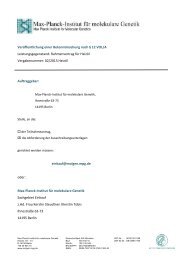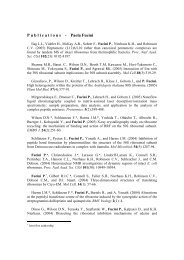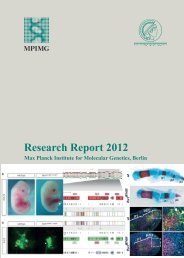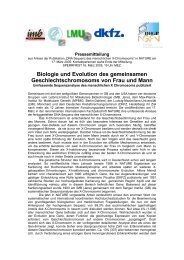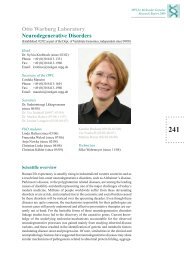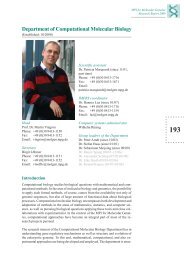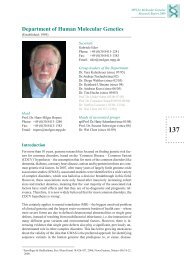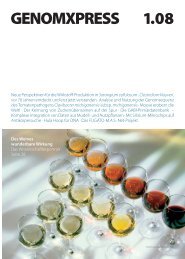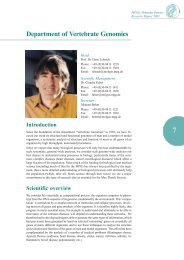Research Report 2003 - Max-Planck-Institut für molekulare Genetik
Research Report 2003 - Max-Planck-Institut für molekulare Genetik
Research Report 2003 - Max-Planck-Institut für molekulare Genetik
You also want an ePaper? Increase the reach of your titles
YUMPU automatically turns print PDFs into web optimized ePapers that Google loves.
Department of Vertebrate Genomics<br />
36<br />
Kinetic Modeling Group<br />
Head:<br />
Dr. Edda Klipp<br />
Phone: +49 (0)30-8413 1717<br />
Fax: +49 (0)30-8413 1380<br />
Email: klipp@molgen.mpg.de<br />
Scientist:<br />
Dr. Axel Kowald<br />
Students:<br />
Sebastian Schmeier<br />
Bente Kofahl<br />
Susanne Gerber<br />
The Kinetic Modeling Group was founded in late 2001, belongs to the Berlin Center<br />
of Genome-based Bioinformatics (BCB) and is supported by the BMBF.<br />
Scientific overview<br />
Mathematical modeling of complex biological phenomena and diseases is an important<br />
approach to combine the accumulating amount of data in biological investigations and the<br />
increasing qualitative understanding of cellular operation in a productive way. The realization<br />
of genomic information in a biological instance is ensured by a complex network<br />
of processes. The dynamic behavior of such processes can’t be understood intuitively.<br />
Only a comprehensive approach allows the understanding of complex system behavior<br />
like optimal regulation or adaptation. We use mathematical models to describe and investigate<br />
cellular processes and regulatory links from gene expression to metabolism.<br />
Projects<br />
Modeling of Signal Transduction in the yeast Saccharomyces cerevisiae<br />
Cells are able to react on changes in the environment. Receptor molecules sense the signals,<br />
several proteins transmit them and, eventually, the expression of several genes will<br />
be changed. Newly produced or quantitatively changed proteins allow for stress response,<br />
be it the production of protecting substances, the change in the intracellular medium, or<br />
the cell cycle arrest to prepare mating. Specific processes under investigation are the<br />
HOG (high osmolarity glycerol) and the pheromone pathway in yeast (papers in preparation).<br />
In co-operation with a Swedish experimentally group (Prof. S. Hohmann, Göteborg<br />
University) we model such processes by identifying individually steps and describing<br />
their dynamics with a system of ordinary differential equations. The systems behavior is<br />
analyzed, alternative models are developed, and computer simulations are performed. We<br />
can reproduce the experimentally observed system behavior in the model and make predictions<br />
for the behavior of mutants and for the outcome of experiments to be designed.<br />
Yeast is used as a model organism, since it is easy to handle and many data are already<br />
available. Signaling pathways are evolutionary highly conserved. From an experimental<br />
as well as from a modeling viewpoint, the developed techniques, the specific results and<br />
the art of interaction of modeling and experimental research can be applied to higher<br />
organisms, in order to arrive at a better understanding of the dynamic operation of those<br />
pathways and to offer new opportunities for drug discovery.



